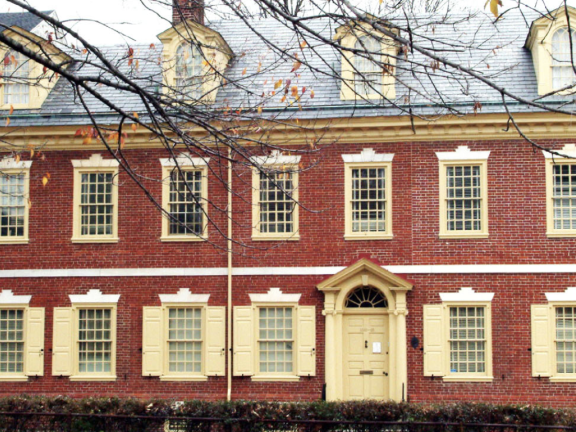Colonial Germantown Historic District

The Germantown historic district stretches for twenty-one blocks along Germantown Avenue from Windrim Avenue to East Sharpnack Street. This corresponds closely with the area that was settled in the eighteenth century, but it encompasses nearly five hundred houses and commercial buildings that were constructed between the early 1700s and the 1950s. This architecture reflects the key role played by Germantown in colonial history and throughout the development of modern Philadelphia.
Germantown was founded in 1683 by a group of Mennonites, Pietists, and Quakers from Frankfurt, Germany. Their leader, Francis Daniel Pastorius (1651-1720), negotiated the purchase of 15,000 acres from William Penn and laid out the town—the first German settlement in North America. Penn granted a charter to the independent community, and Pastorious was its first mayor. He was also a member of the Pennsylvania General Assembly and lived In Germantown until his death.
Germantown played a key role in defining the nation. In 1688 Germantown Quakers promulgated the “Petition Against Slavery,” the first abolitionist declaration in the new world. In 1777, one of the most consequential clashes of In the Revolutionary War was the Battle of Germantown, when American forces showed themselves capable of threatening British positions. And in the summer of 1793, after achieving independence, the American government moved temporarily from Independence Hall to Germantown to avoid the yellow fever epidemic. In the nineteenth century, Germantown was industrialized more rapidly than most of Philadelphia, and early railroad development transformed it into the city’s first suburb.
The historic district includes over fifty buildings that were of importance in the colonial and early republican periods. Most impressive are the great houses, many of which were built as retreats from the increasingly crowded city. These include Cliveden (1763-1764), Grumblethorpe (1744), Loudoun (1801), Upsala (1755, 1798-1801), Vernon (before 1741, 1805), and Wyck (1736, 1771-1773).
The context for these mansions is scores of smaller but distinctive houses that were built along both sides of Germantown Avenue by the German-speaking community of farmers, linen-weavers, and merchants. In many cases these were also places of business and industry. Constructed of local Wissahickon schist, the homes combine traditional German features and elements borrowed from the larger, surrounding English-language culture.
Industrial development was a significant part of Germantown’s history. William Rittenhouse founded America's first paper mill here in 1690, and in 1743 Christopher Sower's printing establishment published the famous German Bible, the first Bible printed in America in a European language. Tanning yards and water-powered textile mills also flourished before 1800. In the nineteenth century, this activity accelerated: the textile mills converted to steam power, and the Germantown and Norristown Railroad, one of the first in the nation, arrived in 1832. In 1859 a horsecar line connected Germantown with the city into which it had been incorporated in 1854, and a second train line, the Pennsylvania Railroad, was built in 1884.
After the Civil War, Germantown Avenue became the commercial corridor for what was both a suburb and an industrial district. Its appearance was transformed by the insertion of Italianate and Second Empire style commercial buildings among the eighteenth-century houses and mansions.
The construction of a new Germantown Town Hall in 1923-1925 (designed by John Penn Brock Sinkler in imitation of William Strickland’s Merchants’ Exchange) signaled the continuing importance and separate identity of the district. The intersection of Chelten and Germantown Avenues became a destination for shoppers from throughout northwest Philadelphia, anchored by Allen's Department Store (designed by Clarence Wunder, 1927) and the C.A. Rowell Department Store (Arthur Brockie, 1929, and Herbert Beidler, 1949). When purchased by Curtis Sisco in 1974, Rowell’s became the first African American-owned department store in the United States.
Photo credit: Historic Germantown